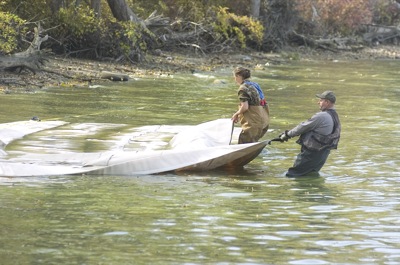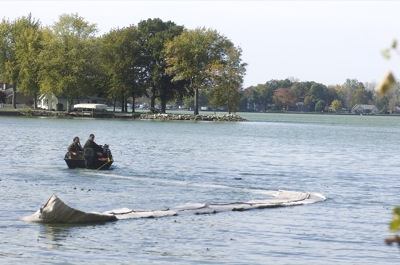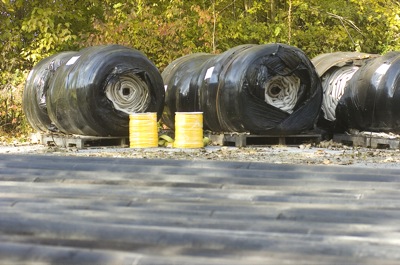Tuesday, October 20th, 2009
Geotextile tube project begins
Tubes will be filled with lake muck and placed along shoreline to protect it
By Nancy Allen

Photo by Mark Pummell/The Daily Standard
Laura Walker, coordinator of the Grand Lake/Wabash Watershed Alliance, and Ken Norman of Metropolitan Environmental Services drag a geotextile tube out into Grand Lake to place along the shore in the Windy Point area Monday morning. The watershed group and Grand Lake St. Marys State Park officials are partnering on the project to use geotextile tubes filled with lake sediment to stabilize the shoreline.
Setup has begun for an experimental project using geotextile tubes filled with dredge material from Grand Lake to stabilize the shoreline in the Windy Point area.
The Grand Lake/Wabash Watershed Alliance and Grand Lake St. Marys State Park are partnering on the project. Officials should begin filling the geotextile tubes with sediment dredged from the lake some time this week, said watershed coordinator Laura Walker.
Geotextile tubes are giant filter bags, made of high strength polypropylene geotextile, that can be filled with different types of liquid waste or dredge material. Local officials will use eight, 100-foot-long tubes for this project.
After the tubes are pumped full of dredge material, they will remain along the shoreline permanently to act as a breakwater and lessen erosion caused by wind and wave action. A layer of riprap may be placed on top of the tubes in the future.
The devices have been used successfully on Lake Erie and in hurricane prone areas in the ocean.
Walker said she and state park workers began preparing the site Monday morning, unrolling the geotextile tubes, putting them in place with stakes and splicing together dredge line.
"We might get them in place today and we may also get all the pipe put together," she said Monday morning. "We have to take the bags across the channel, place them and unfold them too."
Walker said a $50,000 federal Conservation Innovation grant is being used to fund the project, along with $25,000 in state capital funds and $25,000 in local matching funds in the form of dredging by state park employees and her monitoring the project.
"We want to find out if the
geotextile tubes will be an economical way to protect the lake shoreline," Walker said. "We may find it is or we may find out there are too many things to be figured out and it's not economical."
The state typically uses rip-rap (large rocks) along Grand Lake's shoreline to protect it and keep it from washing away. Shoreline erosion is a big problem on the lake and many islands that used to be present in the lake have washed away. Protecting the lake's shoreline and its islands also is a way to keep excess sediment out of the lake and improve water quality.
Walker said she will perform tests to determine how much phosphorous in the lake muck is retained in the geotextile tubes.
A polymer will be added to the dredge material that causes the solids to clump together. The clean water then will run from the bags back into the lake - a process called dewatering - leaving the now solid mass of sediment in the bag.
Walker said she should have a report on the project written in about six months.

Photo by Mark Pummell/The Daily Standard
A geotextile tube is drug by a boat across the lake to be placed along the shoreline in the Windy Point area.

Photo by Mark Pummell/The Daily Standard
Geotextile tubes wait to be unrolled and positioned along the shoreline.

